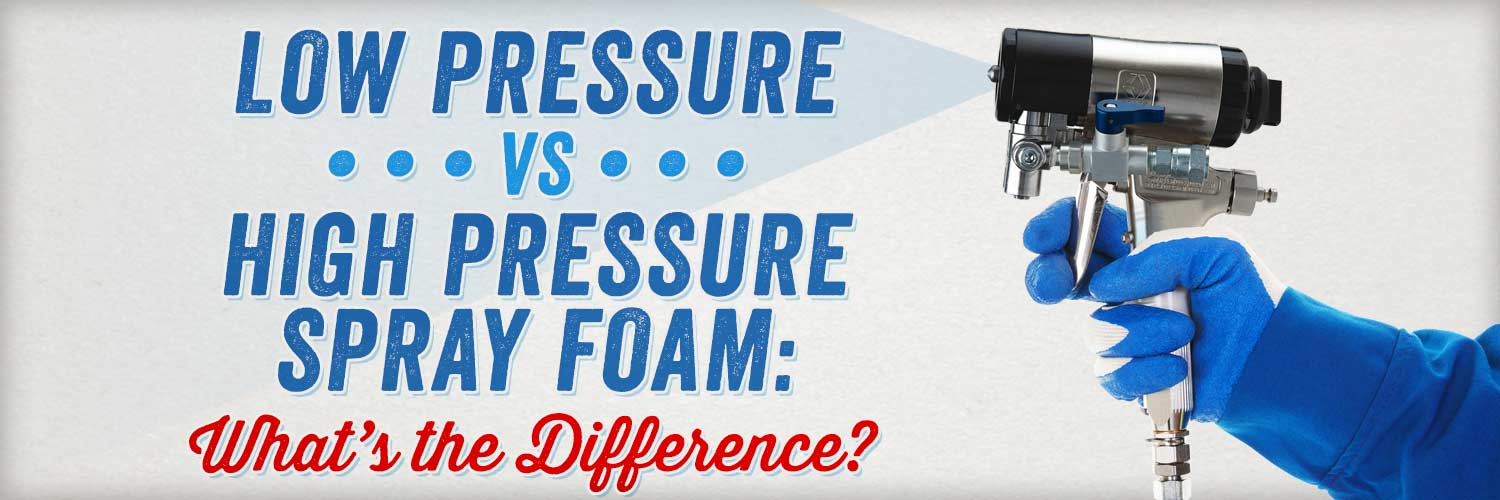Low-Pressure vs High-Pressure Spray Foam: What’s the Difference?


Do you want spray foam insulation for your home, pole barn, or other projects, but you don't know if you need low-pressure or high-pressure foam spray?
It comes down to whether you want to do it yourself or have professionals do it for you.
RetroFoam of Michigan has been insulating homes with spray foam insulation since 2002, helping thousands of homeowners make their houses more comfortable and energy-efficient.
In our continued efforts to educate homeowners like yourself, we will discuss the difference between low-pressure and high-pressure spray foam, how they both work, and which product is best.
The Difference Between Low-Pressure and High-Pressure Spray Foam
The very basic difference between low- and high-pressure spray foam is the rate at which the material moves through the hose and out of the gun.
Low-pressure spray foam is usually found in DIY froth kits, which can be used by homeowners to insulate small places, like around electrical outlets. It can also be found in cans that can also be found at home improvement stores.
High-pressure spray foam is the material you see insulation contractors install in homes, commercial buildings, and pole barns.
Low-Pressure vs High-Pressure Spray Foam: Which is Better for Your Home?
The answer to this question really comes down to several factors – do you have experience spraying foam, how big is the project, as well as knowing what to expect?
Low-Pressure Spray Foam Insulation
You can find low-pressure spray foam at many home improvement stores as a DIY kit.
When working with a DIY kit, it’s important to know how the pack is going to work.
Low-pressure spray foam doesn’t cure as fast as high-pressure, therefore you need to be mindful of the amount of material you’re spraying so you don’t waste any product.
If you use low-pressure spray foam, it’s important to keep spraying once you start. This is how many homeowners end up wasting product.
Because these kits have a low spraying pressure, there isn’t air constantly moving through the hose and gun. When there isn’t constant air moving through the hose and gun, the liquid product will begin to cake up and clog them both.
Low-pressure kits should only be used for small projects like around doors, headers around windows, or to fill in the spaces around your cold air returns.
Most experienced insulation contractors wouldn’t use low-pressure spray foam to insulate your home due to the cost and the difficulty of installation.
High-Pressure Spray Foam Insulation
High-pressure spray foam is the material you see experienced insulation contractors install in homes.
While you can install low-pressure spray foam in certain small spots in your home, high-pressure foam can only be installed correctly by professionals.
That’s because to create that high pressure for the hose and the gun, the system is run out of a truck with a generator where the foam is mixed in a proportioner. This professional machine is only used by experienced contractors to ensure the spray foam is mixed properly.
The high-pressure created keeps air moving in the hose and the spray gun, so there isn’t a buildup of product.
High-pressure spray foam also cures much faster than low-pressure, and because of this, installers know exactly how much foam needs to be sprayed in a cavity to fill it up.
Getting Started with Spray Foam
When it comes to choosing spray foam for your insulation project, the choice is yours and comes down to the difficulty of the job and your experience.
Low-pressure spray foam used in the froth pack kits can work if you know how to use them but can leave a huge mess and waste a lot of money if you misstep. High-pressure spray foam is the better fit if you want to leave it to the professionals.
To learn more about how spray foam can benefit your home, check out the Learning Center on our website.
Related Articles
Open Cell vs Closed Cell Foam Insulation: Which is Better for My Home?
What’s Inside Your Foam Insulation Contractor’s Rig? Here’s Why the Equipment Matters
DIY Spray Foam Insulation Kits: What are They? How Do They Work?
About Amanda Ringler
Amanda previously has worked as a breaking news and crime reporter, TV news producer, and editor in Flint and Detroit. Throughout her career as a journalist, she has won several awards from The Society of Professional Journalists - Detroit Chapter and the Michigan Press Association. As part of the RetroFoam of Michigan family, Amanda uses her experience as a journalist to write content that will help educate homeowners on the benefits of foam insulation. When Amanda isn’t writing, she’s spending time with her husband and rescued huskies. She also loves knitting, making art, cooking, and hosting dinner and a movie night for friends and family.

.jpg)
